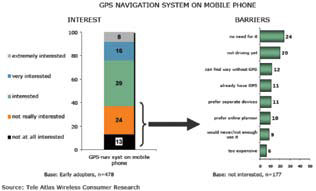| LBS | |
The drivers for a successful take off of LBS
Remi Challamel
|
|||||||||||||||
Business driversBusiness drivers remains also fundamental. There is first the need of developing existing revenue streams: • Enhancing existing service (yellow pages, advertising) through greater location accuracy; • Provide greater customer satisfaction New revenue streams should also be created, through offering of new services (personal tracking, social networking), dependant on high accuracy localization (availability today of more accurate GNSS system, like EGNOS). And strong marketing effort shall be maintained, like • Special Offers, Rebates, .. • User education • Sales force education • Clear prices and business model Technical driversThe killer technology that really drove growth of the 1st LBS generation up to now was the development of assisted-GPS technology. But such technology, though offering positioning services in outdoor and light indoor situation, doesn’t cover all the situation met tomorrow by the users. In the future, next challenges will be: • To accelerate implementation of high QoS (accuracy, integrity) systems: augmentation system like EGNOS could definitively be better exploited • To develop indoor technologies well adapted (technically, operationally, economically) to LBS • To develop cheaper, more powerful and more friendly LBS handsets (200M GPS phones end 2008) • To improve ease to use and integrated LBS applications • To go on extending Digital map, especially for indoor environment ConclusionThe LBS market, after difficult period [2000; 2005] is now taking off, and all indicators are“GREEN” for further growth. The killer technology that really drove growth of this 1st LBS generation, after 2005, was the development and availability of assisted-GPS technology. The key drivers for next generation are: standard, techno, regulation, marketing & usability. First generation of successful LBS is available, generates profit!… and laid the foundation for secondgeneration applications which will be more accurate, with better indoor penetration, and suitable for navigation purposes, as well as advertising and location-based social networking.” AcknowledgmentThis paper was written in the context of the research activities of the European project LIAISON. LIAISON is a research project led by Thales Alenia Space and involving 34 other European partners, which aims at developing Location Based Services for professional markets. LIAISON has received research funding from the Community’s Sixth Framework Program. Special Thanks to the fruitful support of Thales Alenia Space Team (Laurent Claverotte, Hervé Buret, Olivier Guilbert, Fabrice Rialet, Yves Capelle, Michel Monnerat). References[1] LIAISON www.liaison-project.eu/ [2] Teleatlas wireless consumer research [3] http://www.liaison-de.eu/. |
|||||||||||||||
|
|||||||||||||||
|
Pages: 1 2


















 (No Ratings Yet)
(No Ratings Yet)





Leave your response!